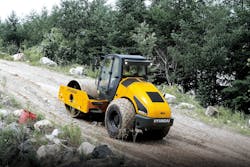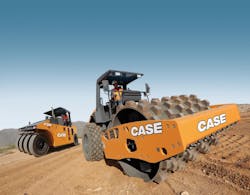The ride-on soil compactor/roller market is relatively flat, as manufacturers are still waiting to see a real bump from infrastructure spending, but market conditions haven’t stopped them from adding technology to improve efficiency and ultimately save fuel.
“AEM shows that the year-over-year numbers are almost exactly flat through June [1,584 year-to-date June 2016 versus 1,528 year-to-date June 2017],” says Juston Thompson, product specialist for Hyundai Construction Equipment. “I imagine the U.S. and Canadian markets are similar in that the infrastructure spending that drives this segment is only starting to kick in and roller purchasing has not caught up yet.”
Cost of Ownership
Tim Hoffman, product manager, rollers, for Dynapac, says the soil compactor market is slightly up. “There are many bigger projects going on—highway expansions, and a lot of housing and commercial projects—but still not a lot of new construction as it relates to government,” he says.
“Overall, the market is similar to last year,” adds Baven Kuruvilla, global sales consultant for Caterpillar. “There appears to be interest in smaller compactors fit for building construction applications, as well as larger soil compactors for demanding applications.”
*Hourly rate represents the monthly ownership costs divided by 176, plus operating cost. Unit prices used in this calculation: diesel fuel at $2.53 per gallon; mechanic’s wage at $58.29 per hour; and money costs at 2.5 percent.
Source: EquipmentWatch.com
Managers in the market for soil compactors (the most common of which are single-drum vibratory rollers) should weigh a number of factors before making a purchase, including material type, roller characteristics and versatility, gradeability, and technology.
“The first factor to consider is the material type being compacted,” says Volvo product manager Mark Eckert. “Smooth-drum compactors are best used for granular materials, while padfoot-drum compactors are best for cohesive soils. Most manufacturers also offer padfoot shell kits to convert smooth-drum machines to padfoot.”
Ed Brenton, brand marketing manager for Case, also advocates padfoot shell kits. “This will allow more versatility and can save cost versus buying a standalone padfoot machine. That way a contractor can compact sand and gravel along with cohesive soils like clay and silt; there’s a little bit more versatility than buying either a standalone smooth drum or a standalone padfoot. Having said that, if they are fortunate enough to be able to buy one of each, that would be ideal. That way they don’t have to switch that padfoot shell kit on and off the machine as they go from job to job, or within jobs,” Brenton says.
“Other factors related to productivity are static weight and dynamic force,” Eckert says. “Heavier machines with wider drums and heavier weights are typically used on larger projects where thick lifts are being compacted. Smaller machines with narrower drums may be more suitable for utility applications, such as pipelines and trenches. In these applications, a fill-spreading blade is commonly used.”
BOMAG’s product manager for heavy compaction, Bert Erdmann, also focuses on productivity, but adds climbing grades as a consideration.
“Higher compaction performance delivered by the roller reduces the number of required passes,” Erdmann says. “Pay close attention to a roller’s compactive effort, which can be determined by examining the static linear load at the drum and the maximum amplitude. Contrary to popular belief, centrifugal force is not a factor.
“Single-drum rollers, especially larger models, often will be working at steep grades in applications such as dam and landfill cell construction,” Erdmann explains. “Rollers that are designed with dual-pump drive systems—one for the drum and a separate one for the rear axle—will deliver gradeability reaching 60 percent.”
There are other factors related to climbing, as well. “A center articulation/oscillation joint also contributes to a roller’s climbing performance,” Erdmann says. “The ability of the joint to oscillate keeps both the drum and tires in constant contact on irregular terrain, so the roller can better climb steep grades.”
Brenton urges managers to think about roller size. “Buy the largest machine you can afford. Larger machines don’t cost much more to maintain and will offer significant gains in productivity,” he says.
“These machines are made for compacting large open areas, and having a compact machine won’t necessarily save them any money in the long run if they can buy a larger machine and get more done in less time,” Brenton says. “The larger machine has a bigger footprint, and will usually...[mean] that they can compact more material in one pass. They could compact a higher lift a lot quicker than with a smaller machine.”
Kuruvilla references the technology built into the latest rollers. “Managers should look for technology that helps their operators perform better; however, the technology should be simple to use,” he says.
That technology is one way to keep costs down, according to Kuruvilla. “One of the biggest potentials for lowering costs is to reduce or eliminate unnecessary passes. Two ways to accomplish this are to provide technology that helps the operators keep track of passes, and to choose the proper machine. There are a wide range of 84-inch drum rollers available with differing performance levels. Selecting the right machine for the job ensures that the machine will produce at peak efficiency. And remember that high speed does not always equal high production. Keep a consistent speed but select the correct size machine for the best results,” he says.
“Intelligent compaction (IC) could be a very useful tool in making sure the operator isn’t making more passes than required and overcompacting,” Dynapac’s Hoffman says. “Dynapac’s IC system, called Dyn@lyzer, tracks pass count, coverage, and can also detect weak spots. It’s designed to make sure the operator gets 100 percent coverage and the correct number of passes required, because doing more passes than required means more time, which means more money.”
“Make sure operators are keeping their idle times to a minimum,” Case’s Brenton says. “If the machine is not in operation, they should just shut it off instead of leaving it sitting at idle until they’re ready to compact with it. This will reduce the total amount of fuel burned during the day. Another fuel-savings tip is to make sure that operators are properly trained and able to avoid over-compacting an area, which will result in burning excess fuel and spending time compacting an area that has already reached maximum density.
“Over-compacting can be overcome by installing or purchasing a machine with a compaction monitoring system that can notify the operator when the soil has reached optimal soil conditions,” Brenton says. “The monitoring system will detect when the soil has reached that maximum soil density, that soil stiffness, and it will tell the operator to move on to the next section. That will help with fuel costs and wear and tear on the machine.”
Volvo’s Eckert stresses maintenance and taking advantage of manufacturers’ telematics offerings to keep operating costs down. “Preventive maintenance and regular inspections of major components can reduce downtime and repair costs. Most manufacturers offer service contracts or agreements and extended warranties to help control operating costs over the life of the machine.
“In recent years, telematics has become a solution to help managers keep operating costs down,” Eckert says. “Telematics can be installed on machines to allow fleet managers to monitor machine operation. Or, in the case of Volvo ActiveCare Direct, the OEM provides the monitoring and delivers specific recommendations to the customer and/or dealer when an action or repair is needed, which helps catch problems before downtime occurs.”
Rollers are fairly easy to maintain compared to other types of machines, but that doesn’t mean there can be less attention to detail.
“Understand maintenance requirements and don’t take for granted that the maintenance is the same as previous rollers,” Caterpillar’s Kuruvilla says. “Some manufacturers offer extended maintenance on certain systems, such as three years or 3,000 hours on vibratory and hydraulic systems. Don’t assume it is ‘yearly or 1,000 hours.’ Check your manual, because you might be spending money you don’t need to.”
It’s also important to be aware of greasing requirements.
“Many of the rollers on the market today require greasing the moving parts, and it is quite common for the person doing the daily maintenance to over-grease or not to grease enough,” says Erdmann. “Over-greasing the joint creates grease deposits on the outside of the components, which attracts dirt and increases wear. Alternatively, not greasing sufficiently will increase the risk of accelerated wear and premature component failure. Selecting a roller that requires no daily greasing reduces operating costs through the elimination of time-consuming daily greasing as well as increasing component longevity.”






